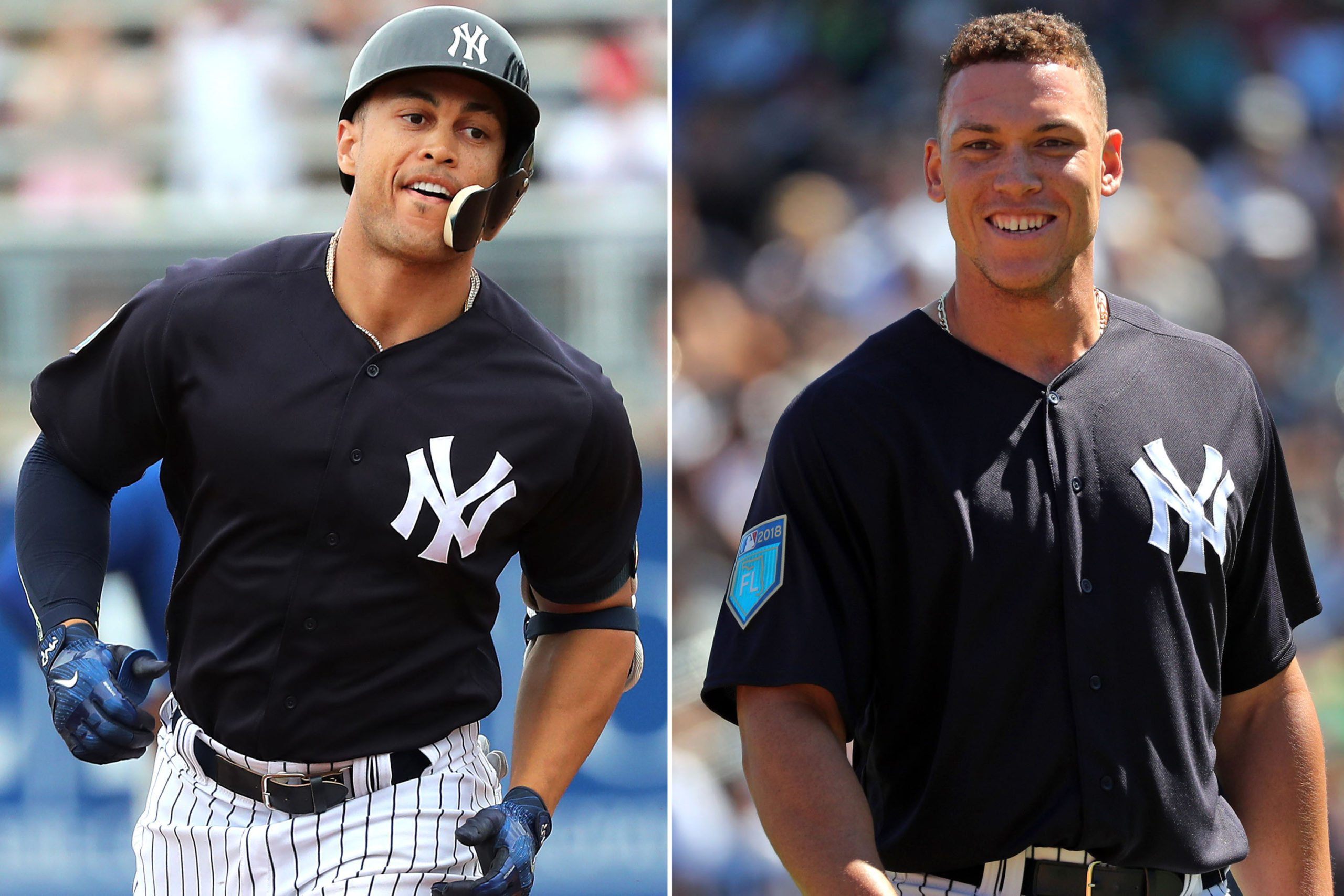
Giancarlo Stanton and Aaron Judge
 Baseball fans and analysts alike have begun to embrace advanced metrics. Over recent years, I’ve begun to have a much more open mind to these new statistics. I love baseball history and, as such, have a soft spot in my heart for the “classic” statistics—batting average, home runs, RBI, runs, etc.
Baseball fans and analysts alike have begun to embrace advanced metrics. Over recent years, I’ve begun to have a much more open mind to these new statistics. I love baseball history and, as such, have a soft spot in my heart for the “classic” statistics—batting average, home runs, RBI, runs, etc.
But to quote Matt Smith, who played the Eleventh Doctor in the British television series, Doctor Who, “times change and so must I.”
And with that, let’s take a look at exit velocity. There are certain players who can just destroy a baseball upon contact with the bat. Yankee teammates Giancarlo Stanton and Aaron Judge are among such players. However, I didn’t realize just how much power they generate until I did some digging.
Statcast is the go-to place for advanced metric statistics. They go back to 2015 when it comes to exit velocity data. In other words, the statistic is relatively new.
Anything hit with an exit velocity of 95 miles-per-hour or better is quantified as hard hit. I chose to use 115 MPH to show that this these baseballs weren’t just hit hard—they were annihilated.
Here are the players with the most base hits at 115 MPH or higher since the start of the 2015 season.
Giancarlo Stanton – 55
Aaron Judge – 30
Carlos Gonzalez – 12
Joey Gallo – 11
Nelson Cruz – 11
Or, let’s look at this another way. There have been 198 base hits to travel more than 115 MPH. Stanton and Judge have combined for 85 of them—or 42.9%. The rest of Major League Baseball have combined for 113 such base hits. Stanton and Judge will be teammates for at least the better part of three seasons—Stanton has an opt out clause in contract following the 2020 season. These two sluggers could end up being one of the most powerful duos in MLB history.
Justin Verlander
 The former American League MVP and Cy Young winner has put up insane numbers for the Astros this season. His 1.24 ERA is the best among major-league qualifiers. He allowed just two earned runs in six innings against the Red Sox on Saturday. That outing raised his season ERA from 1.11-to-1.24.
The former American League MVP and Cy Young winner has put up insane numbers for the Astros this season. His 1.24 ERA is the best among major-league qualifiers. He allowed just two earned runs in six innings against the Red Sox on Saturday. That outing raised his season ERA from 1.11-to-1.24.
He’s struck out 104 batters in 87-and-a-third innings this season—a 10.7 strikeouts per nine ratio. That’s on pace to be the highest of his career, surpassing his 10.1 K/9 ratio in 2009. Keep in mind, Verlander was 26-years old in 2009. He’s 35-years old this season.
Entering play on Sunday, Verlander is on pace for 19 wins and 281 strikeouts in 235-and-a-third innings for the 2018 campaign.
This might not just be a great season for the Astros’ ace—it might be one of the best seasons in Major League Baseball history. Granted, he’s made just 13 starts this season, which is roughly one-third of a full season. Maybe I’m getting ahead of myself.
Maybe I’m not.
Verlander is on-pace to have the fifth-lowest ERA in the majors since it became an official statistic. ERA became an official statistic in 1912 for the National League and 1913 for the American League. Dutch Leonard posted a 0.96 ERA in 224-and-two-thirds innings for the 1914 Red Sox.
Not counting Verlander, here are the top five lowest ERA’s since 1912.
Dutch Leonard – 0.96 ERA – 1914 Red Sox
Bob Gibson – 1.12 ERA – 1968 Cardinals
Walter Johnson – 1.14 ERA – 1913 Senators
Grover Cleveland Alexander – 1.22 ERA – 1915 Phillies
Walter Johnson – 1.27 ERA – 1918 Senators
Gibson, Johnson and Alexander are each Baseball Hall of Famers. Leonard was an underrated pitcher for the Red Sox and Tigers. He pitched eleven seasons in the majors from 1913-to-1921, and 1924-to-1925, posting a career 2.76 ERA in 2,192 innings. Leonard was also a two-time World Series champion for the Red Sox in 1915 and 1916.
Verlander’s domination of major league hitters isn’t limited to ERA alone. The 2017 American League Championship Series (ALCS) MVP is on-pace to have the lowest WHIP ratio (walks and hits per innings pitched) in MLB history. The record currently belongs to Pedro Martinez, who had a 0.74 WHIP for the 2000 Red Sox. Verlander currently has a 0.72 WHIP, having allowed just 46 hits and 17 walks this season.
Let’s see how long this continues. It’s possible, if not probable, that the 14-year major-league veteran and future Hall of Famer won’t finish 2018 with such astounding numbers.
Or is it?
Jacob deGrom doesn’t lose—but the Mets do
Jacob deGrom is coming off one of his best starts of the season on Saturday against the Cubs. The 29-year old right-hander allowed one earned run in seven innings and matched a career-high by striking out 13. He took a no-decision in a Mets’ 7-1, 14-inning defeat.
deGrom is 2-0, with a 0.57 ERA in his last eight starts. He’s allowed just three earned runs in 47-and-a-third innings during that span. However, the Mets have lost six of those eight starts. It’s no fault of deGrom’s, mind you. New York has scored a combined total of ten runs in those six losses. To phrase it another way, they’re averaging 1.7 runs per game during those six outings.
Let’s take it another step. deGrom is second in the majors this season with a 1.49 ERA in 12 starts this season, which trails only Verlander for the major-league lead. The Mets have lost seven of deGrom’s 12 starts this season. Entering Sunday, the Mets had a better record at 22-22 when their ace isn’t on the mound!
This would be rare feat indeed. Since Major League Baseball went to a divisional format at the start of the 1969 season, there’s only been one qualified pitcher to finish a season with an ERA under 2.00 and have his club lose a majority of his starts. Roger Clemens led the majors with a 1.87 ERA in 32 starts with the Astros in 2005. However, Houston had just a 15-17 record in Clemens’s starts that season.
Hopefully, the Mets can score more runs for their ace. What more can he do for this club? The answer? Nothing.





